458th Bombardment Group (H)
Crew 33 and FLAK MAGNET
Their Finest Hour

B-24H-10-CF 41-29273 J4 Q Flak Magnet
(Painting: Mike Bailey)
When that second salvo of flak burst almost in front of our formation, I think each of us in the front section of our ship sensed that the next salvo would be in our midst. Obviously the German gunners were getting our altitude, speed, and range. Even so, we weren’t quite prepared for the tremendous impact when the shell slammed through the left side of the bomb bay and tore a huge hole in the top of the fuselage as it exited. For some reason it hadn’t exploded on the way through, but had done great damage.
The shuddering first concussion of that shell was almost instantly followed by a far worse dilemma. Every Liberator crewman’s greatest fear…fuel and fumes inside the airplane! And this wasn’t just a trace of fumes. It was a torrent of raw fuel vaporized instantly, a potential giant fireball waiting for the slightest spark to ignite. We had all seen other B-24’s disintegrate in an instant from the combination of fuel and oxygen.
We were Crew 33, 753rd Bomb Squadron, 458th Bomb Group, 2nd Air Division, Eighth Air Force. Our base was at Horsham St. Faith, a village on the outskirts of Norwich, England. When our group first arrived in England in January 1944, it consisted of the usual four squadrons. At that time each squadron had 18 combat crews and 16 B-24 Liberator airplanes. That meant that each squadron had two crews without an assigned bomber they could call their own. We were one of those crews.
Since we seemed to draw a little more flak and fighter damage than most crews – possibly because our pilot was considered one of the best and we were usually up near the front of the formation – the other crews were not all that happy when we were scheduled to fly their assigned Lib on a mission. On one of those first Berlin daylight raids, we had brought back a badly damaged Bomb-Ah-Dear (March 6, 1944) crashing at Watton and destroying the aircraft. We had all gotten out of that one with minor cuts and bruises. But only because of the skillful action by our pilot and co-pilot when the three operating engines ran out of fuel as we were at about 800 feet and approaching the airstrip.
[This incident actually occurred on March 8, 1944 when Lt. Spaven’s crew was flying an unnamed B-24H 41-28729. This aircraft was on its fourth mission.]
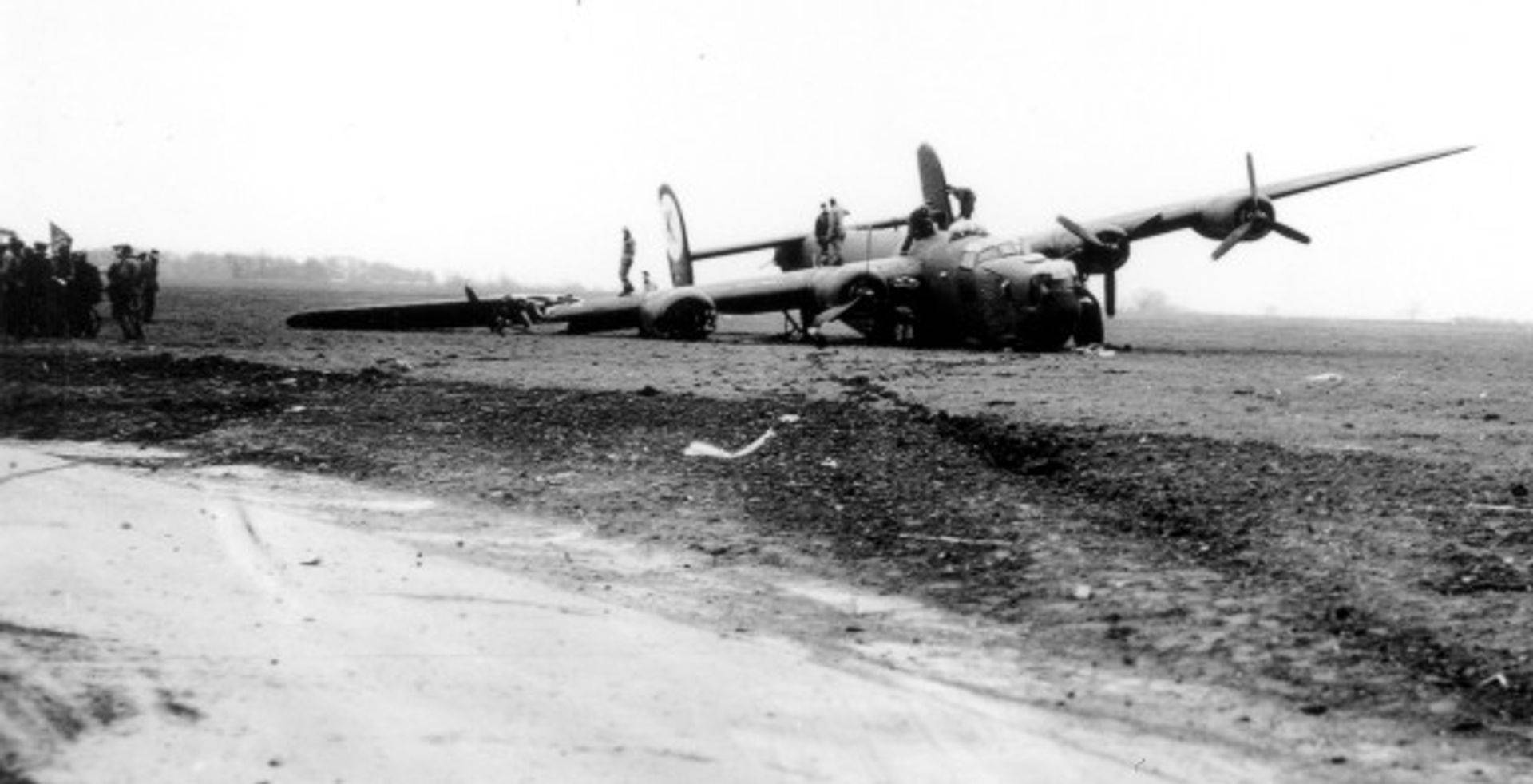
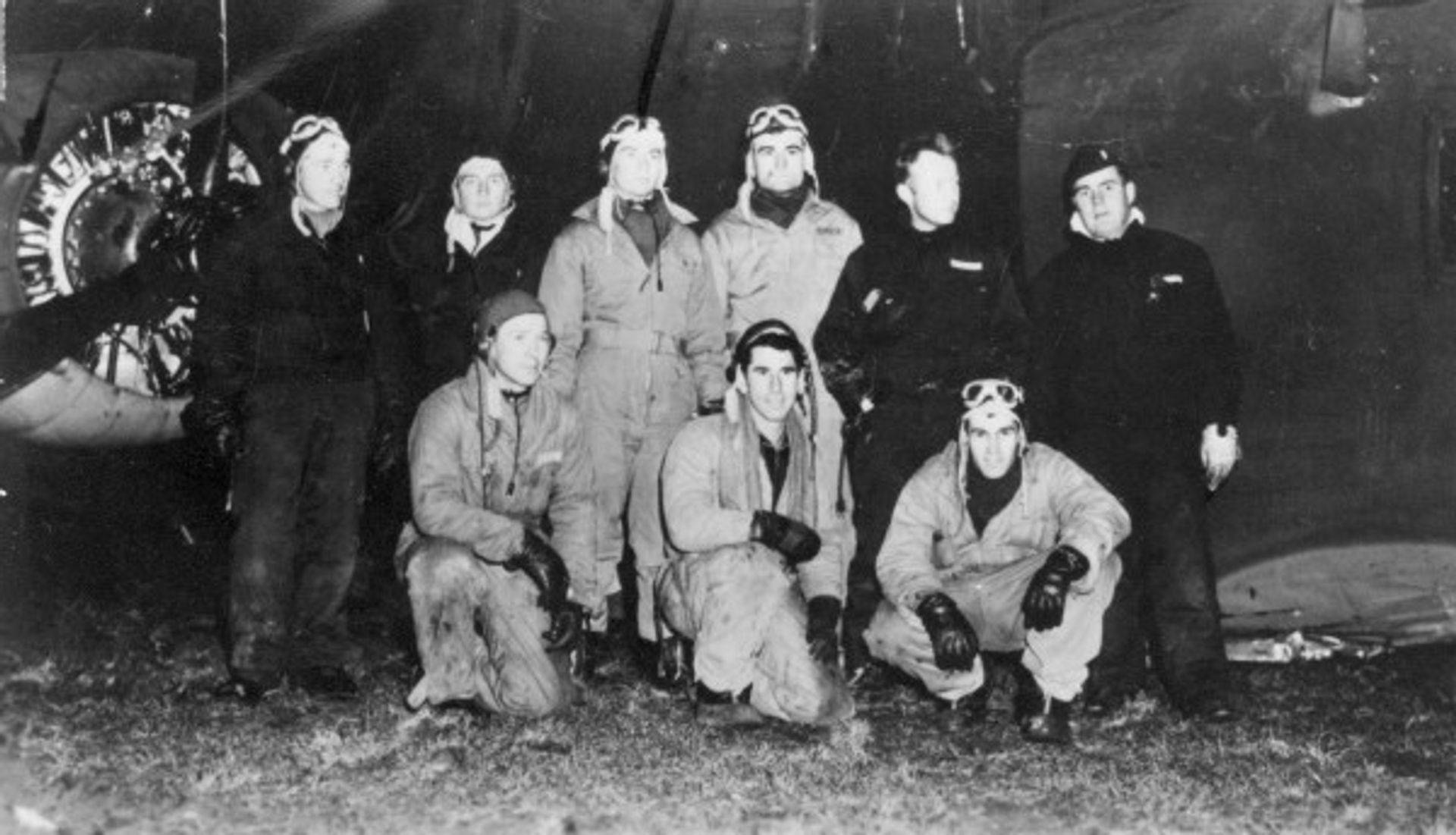
March 8, 1944: Crew 33 – Crash landing at Watton
(Photos: Harold Armstrong)
But this was April 22, 1944, and we were on a strike to hit the strategic rail marshalling yards at Hamm in northwestern Germany. It was late afternoon, around 7:30…on the British ‘double-daylight time’. Standard time would have been 5:30. Our flight engineer, Jim Wedding, was in the upper turret. As crew radio operator/gunner, I was preparing to send a strike report as soon as [the] bomb drop was completed. Jim and I took turns in the upper turret as our responsibilities dictated.
There had been a couple prophetic events those last few days that should have warned us of impending disaster. One occurred about a week earlier. We had been in the aircrew mess hall for breakfast about 2:30 that morning, preparing to head on over to the briefing for that day’s mission – nothing unusual about that. But looking around those familiar surroundings, there was one chilling difference. There was hardly anyone I knew among the 150 or so men present. A couple months earlier, every face would have been familiar. Losses had indeed been heavy.
Wanting to call this to the attention of fellow crew member and buddy Jim Wedding, but not too harshly, I said, “Hey, Jim. Do you notice anything different about the mess hall?” Jim was munching away on his rather tasteless powdered eggs and brownish-grey English bread. He casually glanced around the room and said, “Nope. Looks like the same old mess hall to me.” “Jim, take another look. Who do you see that you know?” He began to scan the room…after a very long look…”Welll, there’s Reynolds’s crew…there’s Manker’s crew….” Then realization struck! Astounded, he turned…”We’re strangers in our own mess hall!” “Yeah, Jim, does that tell you anything?” “It sure does. Time is running out on us. We’re probably not long for this place!” Jim didn’t know how true those words were. No doubt our replacements were at the same table a few weeks later.
Another incident took place that very afternoon, just before take-off on today’s mission. While all the planes were lined up around the assembly area awaiting word to go, Jim and I had been practicing bail-out, as we often did. We timed ourselves, grabbing our parachutes and out the camera hatch, then out the bomb bay or the nose wheel door…trying to cut seconds off our previous times. Replacement gunner, Robert Allin, all enthusiastic about his first mission, was watching in bewilderment. We could tell he was puzzled by our eccentric behavior, but loath to interrupt. Bombardier Jim Mortinson was laying on the tarmac under the plane, reading a comic book. Or, as he often referred to them, his “Officer Training Manual”. So Allin approached him, “Uh, Lieutenant…Lieutenant, what are those men doing?” Mort glanced over…”Oh, Cole and Wedding…they are practicing bail-out. They do it all the time.” And back to the comic book. “Uh, Lieutenant?” “Yes?” “Why are they doing that?” Lt. Mortinson gave him a long look, and then laid it on the line in a way calculated to stop the questions: “Because sooner or later, we’re probably going to get the hell blown out of us!” Then back to the comic book with an air of finality. A lot of the enthusiasm suddenly drained from Allin’s face. Little did he realize that only a few hours later that was exactly what would be happening!
Incidentally, Allin was supposed to be our gunner full time, replacing Sgt. DeSales Glover. Glover had been with us the last few months of training and the first six missions. Impressible, boundless – if somewhat erratic enthusiasm, playing the role with parachute, silk scarf, 50-mission crush hat and a bit of a swagger, a likeable chap. But that sixth mission had been a rough one…Osnabruck, if I remember correctly. A lot of flak damage, almost constant fighter attack…and a confession when we got back to base that night. That mission had cracked Glover’s cocksure confidence. He broke when he saw the crew posting for another mission the next day and our crew was on it. Over and over he kept repeating, “They’re trying to kill me. I’m only 16. I’m too young to die!” He was entered into the infirmary with a bad case of battle fatigue that night. And became somewhat noted as one of the youngest combat veterans of World War II. Despite having more than two years service at that time, it turned out that he was indeed only 16 years old. He had been grounded and later that month returned to the U.S. for an honorable discharge.
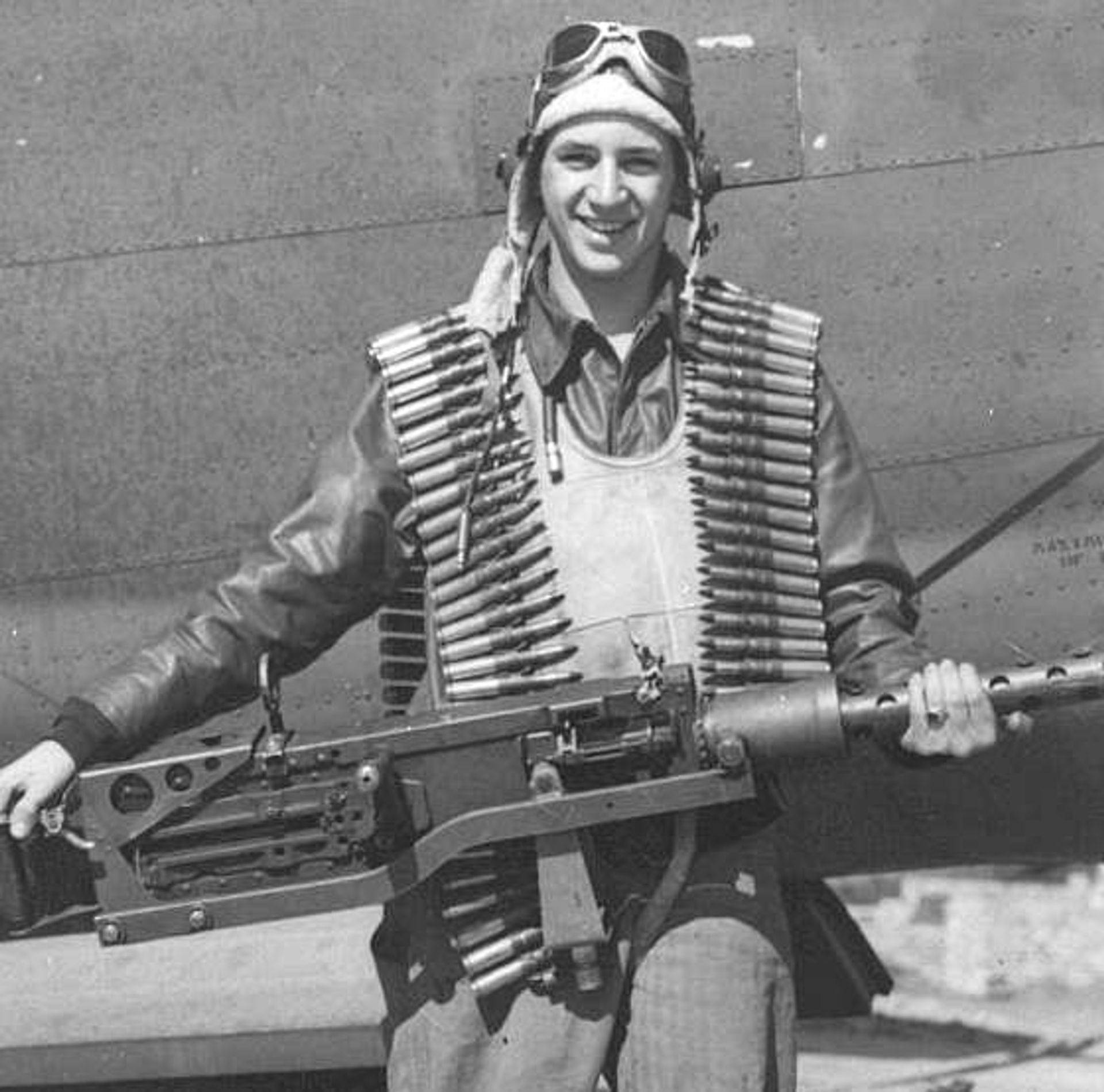
Sgt DeSales A. Glover – 16 years old
But back to today’s mission. As soon as we were hit, Jim Wedding came tumbling out of the upper turret, pale and shaken. We were all expecting the airplane to explode at any moment – and by all rights it should have. To this day none of us know why we were spared. Training and experience with past close calls kept us doing what had to be done. For most of our crew, this was their 12th mission. I had volunteered to fly with other crews when they were short a radio operator, and it was my 18th mission. Wedding immediately began switching fuel lines to stem the flow. We opened the bomb bay doors, knowing the turbulence would increase the fuel vaporization, but would also clear the fuel and fumes from the bomb bay…a calculated risk. Number three engine was out, and our pilot, Lt. George Spaven had feathered the propeller – electrically turning the blades edge-on to the air flow to prevent wind milling vibration.
I straddled the emergency bomb release and pulled the handle out as far as it would go – with no result. On one previous occasion we had tried that emergency salvo release to jettison the bombs and had the same negative result. Evidently it just plain didn’t work, or was tied to the hydraulic system. On both occasions the Number 3 engine had been out, and it was that engine that powered the hydraulic system on a B-24.
At that point Lt. Spaven told me to check on the crew member in the rear of the airplane, since we hadn’t been able to get any response on the intercom. I went back to check the aft section, edging sideways along the catwalk that was the bottom base of the bomb racks and the only way to reach the narrow door into the waist and tail section. Bomb bay doors were still open to clear out the fumes, that narrow walkway couldn’t be traversed with a parachute on; it was ‘hang on the best you can and don’t look down!’
On entering the rear section, it was evident that both waist gunners and the tail gunner were already gone. A quick check on the still-lowered ball turret and I could see that gunner Larry Scheiding had forced open the little sliding doors on his turret and kicked himself free. It was a maneuver he had practiced many times. Being realistic, when a bomber took heavy damage there was rarely time for anyone to hand-crank that turret back up. Many ball gunners left to fend for themselves went down with their planes because they had never learned that maneuver. It was only later that we learned that immediately after taking the initial hit and outpouring of fuel, new crew member Robert Allin had sized up the situation and did the only sensible thing. He had bailed out!
Maybe a head-first out the waist window of a B-24 wasn’t the safest thing to do, but it WAS the quickest way out. And when Lt. James Mortinson had seen Allin going out, it was only natural that he thought there had been an order to abandon ship and did likewise.

April 22, 1944 – Flak Magnet hit and trailing fuel
(Harold Armstrong)
Mortinson had been manning a waist gun that day in a switch with armorer Jim Fittinger, so they could both get experience flying different positions. Fittinger had come to our crew many weeks before to replace a gunner who had been permanently grounded after much of his face had been frozen to the bone on one of the early March raids on Berlin when the air temperature at altitude had been 65 degrees below zero, Fahrenheit. Originally a member of Crew 29, [Lt Jesse L. McMains crew] our buddies all through phase training, Fittinger had been grounded the day they went down. He never recovered from the guilt feeling that he hadn’t been with them that day.
Tail gunner Herman Peacher, noting that everyone else was going out, rolled backward out of his turret, donned his chest-pack parachute and quickly departed. But at least he followed preferred procedure and went out the camera hatch, a much safer exit point in view of the B-24’s huge vertical stabilizers.
Just as I returned to the radio room and was leaning into the cockpit area to tell Spaven that the four men in the aft section had safely bailed out, there was a horrendous shrieking roar and Flak Magnet was vibrating violently. Number 2 engine had a runaway prop, meaning it had quit catching air and was malfunctioning. Working together, Spaven and co-pilot Bob Zedeker quickly feathered the propeller on that engine, tested to ascertain that it was inoperable, made adjustments to regain control of the airplane. With only the two outboard engines still operating and limited fuel remaining, the situation was getting grimmer by the minute.
We had already separated from our formation and by now all knew the badly crippled plane would never make it back to England. Spaven called navigator Pete Kowal for a heading to Sweden, having decided to make a run for it, and we had already turned in that direction. We still had a full load of 12 five hundred pound bombs, and knew they had to go. The remaining two engines could carry the ship fine, but bobs, flak jackets…anything not absolutely essential would have to be jettisoned.
Lt Spaven inter-commed Jim Fittinger to bring his tool kit and come to the bomb bay so that we could begin releasing the bombs manually. That entailed coordinating turning of each pair of release catches with a screwdriver so that the bombs could drop away evenly. Once before, on a mission to Friedrichshafen, our entire load of 100 pound GP (General Purpose) and incendiary bombs had hung up in the control and Fittinger and I had gingerly carried each one by the tail fins to the open area at the front of each bomb bay to release them. That time the very last one had to be disentangled before the pilot could regain control.
With Fittinger out of the nose turret, not a .50 caliber machine gun on the airplane was manned. Lt Pete Kowal was now alone in the nose section, at that point trying to find a heading that would take us to Sweden while avoiding all major cities with their inevitable flak batteries. Jim Wedding was monitoring his fuel gauges to avoid any further loss of fuel and still keep the remaining two engines supplied. Fittinger and I were on the catwalk in the bomb bay, had just gotten the second 500 pounder jettisoned when there was a horrible clatter, something akin to large hailstones battering a tin roof. Suddenly, from within a foot or two of us to the back of the bomb bay, we could see dozens of finger-sized holes appearing…. Then we knew! A fighter was strafing us with .30 caliber machine gun fire…and with no one manning our guns, we were helpless. It was over…time to go!
Wedding and I pulled Fittinger toward us, clipped on his parachute in a second and literally shoved him out that opening left by the bombs so far jettisoned. Then, as we grabbed our parachutes, I heard Lt. Zedeker shout at Spaven, “George! Let’s get to hell out of here!” Wedding took one last look and dove out the bomb bay opening. As I stepped back onto the catwalk to take my turn, Bob Zedeker was pushing to hurry my departure. At that moment there was another heavy chatter of machine gun fire and bullets were ricocheting all around us. We both looked toward the cockpit and saw it disintegrating. Lt. Spaven slumped over the wheel as the ship began to nose down.
At that moment, I dropped headfirst off the catwalk…slammed by the rush of air – waited about two seconds – and pulled the ripcord. Our electrically heated flying suits had been inoperable for some time; we were numb from the high-altitude cold, our portable oxygen bottles had been exhausted and we were still around 23,000 feet. Taking all that into consideration, it seemed safer to pull the ripcord too soon rather than to risk blacking out and not pulling it at all. It was a tremendous jolt when the canopy first snapped open, violent bouncing and thrown about…. Then, eerie silence except for the slight sighing sound of the wind through the shroud lines. Quickly glancing around to take stock of the situation, the first thing I saw was Flak Magnet spiraling down in flames. A mile or so away, two parachutes that I guessed to be Zedeker and Kowal. In the distance were two more that had to be Fittinger and Wedding. More ominous however, about a half-mile away was a German fighter heading straight at me. After completing the frontal attack, the fighter was coming back! We had all heard the stories of parachuting crews being machine-gunned on their way down, and that was my first thought. The FockeWulf 190 veered off slightly, throttled back, and passed by about sixty yards out. As I watched the plane move by, still with some apprehension, the pilot snapped off a sharp salute. Dangling in a parachute at well over four miles up, I was in no position to be a smart-aleck, so I returned that salute with great relief.
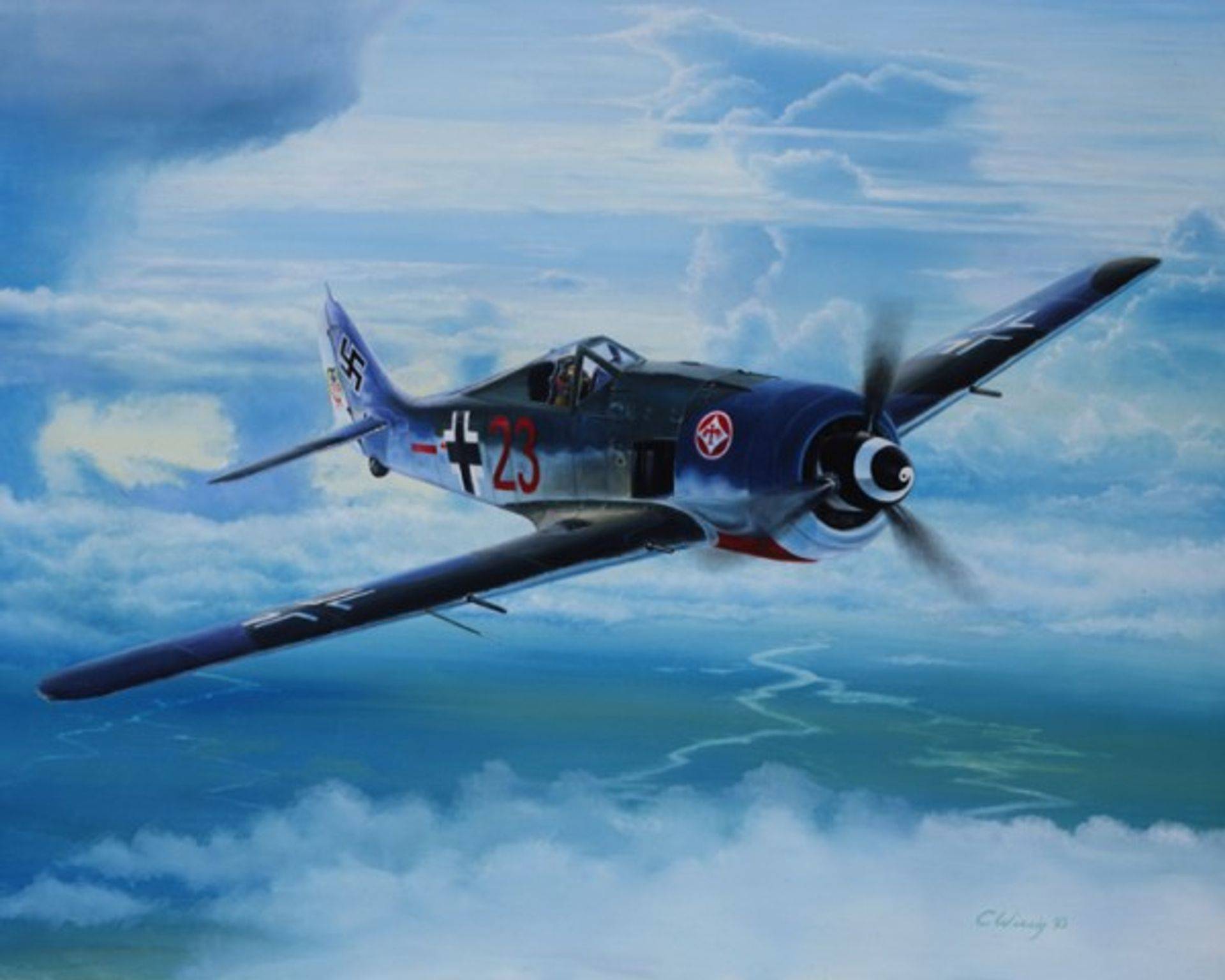
Bär Necessities – Major Heinz Bar’s FW-190 “Red 23”
(Painting by Aviation Artist: Charles Wissig)
Only in recent years did our crew learn that the pilot of that FW-190 was Major Heinz “Fritz” Bar, one of the most famous German fighter aces of World War II. By a twist of fate, Flak Magnet became his 200th aircraft shot down. The noted pilot returned to his base that night and a huge celebration in honor of his 200th ‘victory’ – finishing off a burning and crippled bomber with unmanned guns. But at the time, he didn’t know that, and with his ‘brother-in-combat’ salute to our crew, he was a gentleman in the finest tradition of aerial combat.
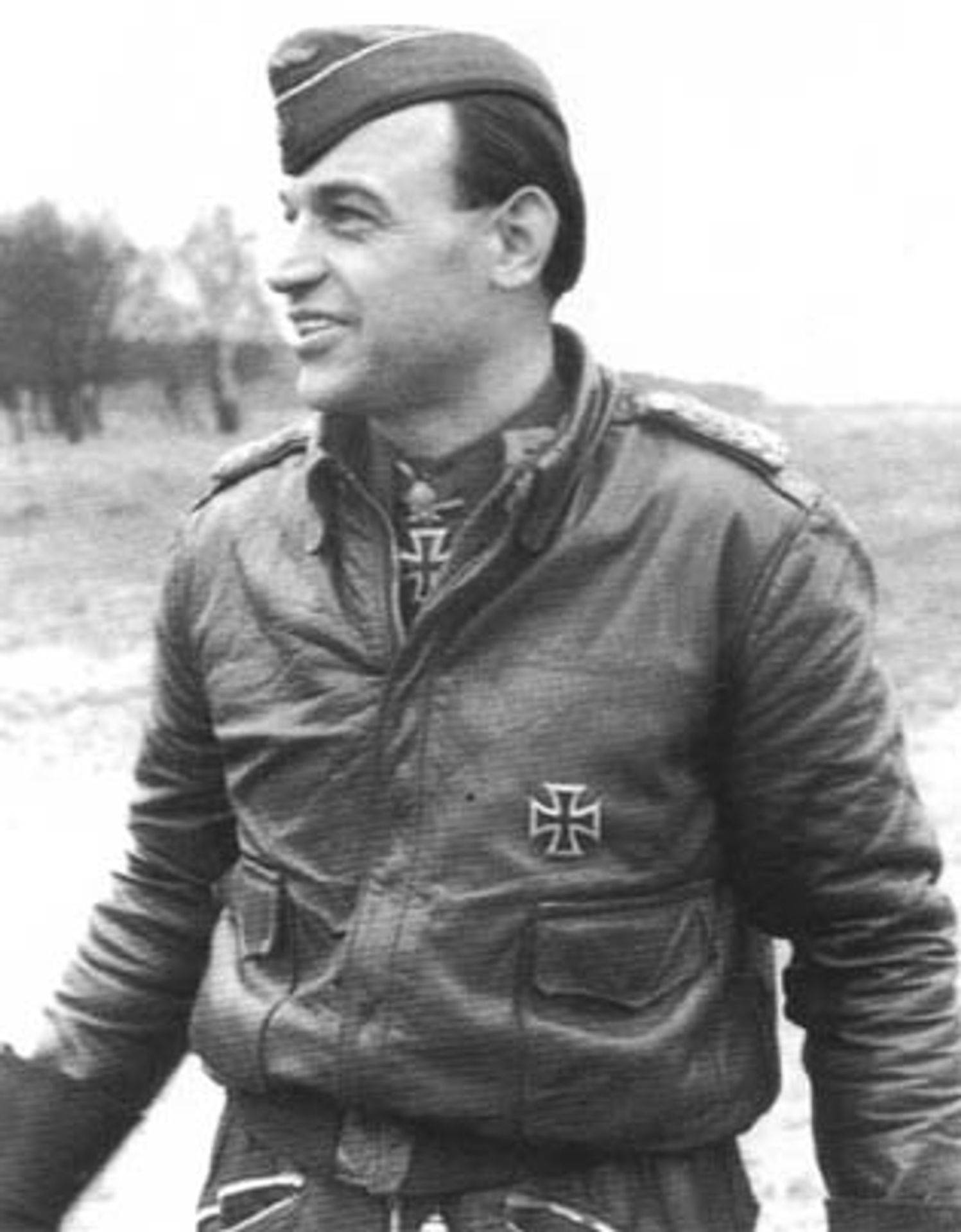

Major Heinz Bar and the tailplane of his Focke Wulfe 190
Right after my ‘chute had opened on bailout, I had taken a quick glance at my army issue hack watch and noted the time…8:03 p.m. It seemed like an eternity before earth appeared to be getting near, and another look at that watch confirmed that it had been 23 minutes up till then. We had always been told that normal descent was about a thousand feet a minute wearing a 24 foot [diameter] chest pack, and that turned out to be quite accurate. What ‘they’ forgot to mention was that at that speed it would take seemingly forever to get down, but that you would hit the ground like a ton of bricks! As I tried to struggle to my feet after impacting the ground rather violently, the reception committee was evident…a group of 35 to 50 armed and angry citizens. They all seemed to have high-powered rifles with scopes. Fortunately, there was one very young, but very authoritative soldier who took charge. He quickly silenced a couple of radicals obviously agitating the crowd to do away with this dangerous ‘flieger gangster’!
It was probably a good thing that at that moment I had no idea what the next few weeks held in store. The days of solitary confinement in various jails, strip searches, threats of death by firing squad, interrogation over and over…several days at a time without even a drink of water. That long train trip to the main interrogation center for American aircrews, Dulag Luft in Frankfurt. There we received more solitary confinement, more brutal interrogation sessions and threats. Then the even longer train trip to Stalag 17 at Krems, Austria. Despite the harsh conditions, those long months at Stalag 17 did have some rewards. Among those, a deep appreciation of freedom and appreciation for the simple things of life that are so often taken for granted. The enduring friendships formed with many fellow prisoners. The next year was to teach many lessons that would last a lifetime. And we were ‘The Lucky Ones’!
One of the first things we would learn was that being a prisoner of war was a big plus right from the beginning. We were still alive to be POW’s! According to our own statistics, on average 6% of the planes on any mission would be shot down. And that on average 60% of the crew members on those planes would be killed at that time. The other 40% would be captured and be prisoners of war. So we were ‘The Lucky Ones’ right from the start.
Several times those first few minutes I did hear that oft-quoted statement that every captured airman seemed to get, “For you the war is over.” They were wrong about that. The war will never be over for any of us until the killing and destruction everywhere is brought to an end. And all that effort and productive capability is turned to the betterment of our world and ALL its inhabitants.
Cedric Cole, courtesy his daughter Sue Knepper
